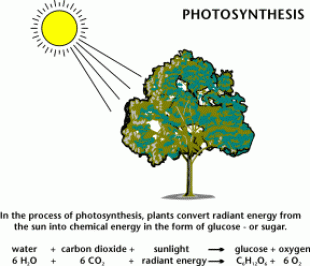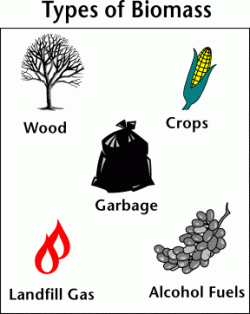How does this Technology work?

*Plants absorb the sun's energy in a process called photosynthesis.
*Chemical energy in plants gets passed on to animals and people that eat them.
*When burned, the chemical energy in biomass is released as heat.
*Chemical energy in plants gets passed on to animals and people that eat them.
*When burned, the chemical energy in biomass is released as heat.
What can this Type of Energy be Used for?

*Biomass fuels provide about 4% of the energy
*About 84% of the wood and wood waste fuel used in the United States is consumed by industry, electric power producers, and commercial businesses
*Biomass can be converted to such as methane gas or transportation fuels, also ethanol and biodiesel.
*Methane gas is the main natural gas. Smelly stuff, like rotting garbage, and agricultural and human waste, release methane gas also called landfill gas or biogas.
*Crops like corn and sugar cane can be fermented to produce ethanol. Biodiesel, another transportation fuel, can be produced from left-over food products like vegetable oils and animal fats
*About 84% of the wood and wood waste fuel used in the United States is consumed by industry, electric power producers, and commercial businesses
*Biomass can be converted to such as methane gas or transportation fuels, also ethanol and biodiesel.
*Methane gas is the main natural gas. Smelly stuff, like rotting garbage, and agricultural and human waste, release methane gas also called landfill gas or biogas.
*Crops like corn and sugar cane can be fermented to produce ethanol. Biodiesel, another transportation fuel, can be produced from left-over food products like vegetable oils and animal fats
What are the Positive Aspects?

*Plants in the wood and paper products industry uses wood waste produces steam and electricity.
*This saves these companies money.
*About one-third of all the ash produced is used, to build roads, to make cement blocks, and even to make artificial reefs for marine animals.
*This saves these companies money.
*About one-third of all the ash produced is used, to build roads, to make cement blocks, and even to make artificial reefs for marine animals.
What are the Negative Aspects?

*Natural gas utilities add a bad smell so people can detect seeping gas,
*When burned, biomass releases carbon dioxide.
*Biomass is very expensive.
*When burned, biomass releases carbon dioxide.
*Biomass is very expensive.
What Percentage of the US Energy Comes from this Technology?
Municipal Solid Waste (MSW) Land Filled or Burned
(MIllions of tons, Total: 169.2)
*Food 18% = 30.9 tons
*Plastics 17% = 28.6 tons
*Glass/Metal/Misc. Inorganic 16% = 27.7 tons
*Wood 8% = 12.9 tons
*Yard Trimmings = 7% 11.7 tons
*Textiles 6% = 10 tons
*Rubber & Leather 4% = 6.4 tons
*Paper/Paperboard 22% =37.8 tons
*Other 2% = 3.3 tons
(MIllions of tons, Total: 169.2)
*Food 18% = 30.9 tons
*Plastics 17% = 28.6 tons
*Glass/Metal/Misc. Inorganic 16% = 27.7 tons
*Wood 8% = 12.9 tons
*Yard Trimmings = 7% 11.7 tons
*Textiles 6% = 10 tons
*Rubber & Leather 4% = 6.4 tons
*Paper/Paperboard 22% =37.8 tons
*Other 2% = 3.3 tons
